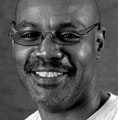
 As we countdown the top stories of 2009, for a small group of Americans and their families there's no top-100 list, top-20 or top-10 list. For these few dozen Americans there's only one story worth recapping: their exoneration.
As we countdown the top stories of 2009, for a small group of Americans and their families there's no top-100 list, top-20 or top-10 list. For these few dozen Americans there's only one story worth recapping: their exoneration.
In 2009, 27 people from 12 states were released and pardoned after serving a total of 421 years in prison for crimes they didn't commit. Since 1989, DNA evidence has exonerated nearly 250 people.
One man who knows what each and every one of those exonerated citizens has been through -- the anger, the elation, the unbridled frustration, the resignation -- is Marvin Anderson whose own celebration came in 2002, 20 years after his nightmare began.
The Virginia teenager was 18 when he was arrested for the brutal rape of a white woman. And although he had nothing to do with the crime, was nowhere near the crime scene at the time of the attack, from the very beginning the odds were against Anderson, a kid with an alibi who had never before been arrested but who was, none-the-less, convicted in less than three hours.
There was hope seven years into his imprisonment, when Anderson watched as Gary Dotson became the first person in the United States to be exonerated by DNA. "He saw it on TV and said to himself, 'that's me,'" says Paul Enzinna, a partner at DC's Baker Botts and a pro-bono attorney for the Mid-Atlantic Innocence Project, a non-profit group whose cause is to free criminals who have been wrongfully convicted. But 12 years later Anderson still sat in jail because the DNA evidence in his case, the evidence that could have proved his innocence, had been "lost."
Not until 2001 when the Innocence Project lobbied for and won legislation that approved "additional search for evidence," did Anderson have any chance of being exonerated for the crime he didn't commit. Finally, luck was on his side as a notebook emerged, a notebook filled with swabs of evidence in his case from the Virginia crime lab. The notebook was the private property of a lab tech who had, on her own, compiled and kept evidence from different cases on which she had worked. "Her collection violated crime lab policy, but it apparently was this woman's personal policy to maintain evidence [in a notebook]," says Enzinna. Less than a year later the evidence was tested and the DNA showed that Anderson was, as he had maintained for two decades, innocent.
Anderson was granted a full pardon in 2002.
He didn't commit the crime, so how is it that Anderson end up in jail? What went wrong? How could it have happened? By studying Anderson's case and the cases of the 248 others exonerated through DNA evidence, The Innocence Project has focused its attention on the root causes of wrongful imprisonment.
1) Snitches, informants who are inmates, account for 15 percent of all wrongful convictions. They "help" police, Enzinna says, by pointing the finger at the accused most often claiming that a defendant confessed his crime while in jail. In exchange, the informant gets favorable treatment in his own case. When asked, "why believe these people," Enzinna's frustation evident, "your answer is as good as mine."
2) False confessions account for 25 percent of all wrongful convictions. The obvious question here is, why would anyone ever admit to doing something they didn't do? Duress, coercion and exhaustion are the main reasons people make false confessions. Enzinna says often police will interview suspects for hours, sometimes even days, leaving them exhausted, telling them whatever they need to tell them to get a confession. By way of example, Enzinna points to the case of a high school senior, Marty Tankleff, whose parents were bludgeoned to death in the family home. Despite the fact that he Tankleff was in shock from the brutal murder of his parents, the police brought the teenager in for questioning one day after the murder, questioning him for days, not allowing him to sleep. Young and unaware of the rules, "he thought if he just confessed he could get out of there and sleep and then explain everything later, prove it later," explains Enzinna. But Marty Tankleff spent nearly 20 years in jail unable to prove that he had made his original confession under duress. He was exonerated in January 2008.
Diminished Capacity. Those with a mental impairment will often admit to crimes they didn't commit. "By nature, the mentally impaired like to help and 'please.' The officers questioning them may lead them," says Enzinna, "give them the answers they are looking for until the person confesses."
Barganing is another tool used by police to get false confessions. Police may tell a suspect that if they confess they'll get a lesser sentence. Or, they may threaten the suspect, even assault him.
Ignorance of the Law. Like Tankleff, suspects often don't know or understand the law. They may not know they can ask for a lawyer. And even if the suspect does ask for representation, it's not uncommon for police to refuse to hear their request. Other times the police may "explain to the detainee that involving a lawyer will just make things so much more complicated," Enzinna says. Finally, a suspect may not ask for a lawyer because he believes asking for one will make him look guilty.
3) Forensic science can be blamed for 65 percent of all wrongful convictions. "Juries put a lot of weight on scientific evidence even though it is often deliberately or accidentally mishandled, not fully analyzed or not even scientific ... junk science," says Enzinna. In addition, most often the forensic scientists presenting evidence are not impartial because "they actually work for the police," Enzinna points out.
4) Eyewitness misidentification accounts for 75 percent of all wrongful convictions. "There's nothing more convincing than a live human who takes the stand, points a finger at defendant and says 'that's the one... I'll never forget him as long as I live'," says Enzinna. But, studies show that eyewitness ID-ing is unreliable, that at times of stress people do a very poor job of describing an attacker. Studies have also shown that eyewitness ID-ing is especially poor when it is cross-racial.
In Part III, Fixing the System. Last time, Anderson's story.
Read, Picking Cotton, by Jennifer Thompson, the story about Thompson's misidentification of Ronald Cotton. And, Forgive Me, by the woman who accused Gary Dotson (the first person to be exonerated by DNA) of rape.
